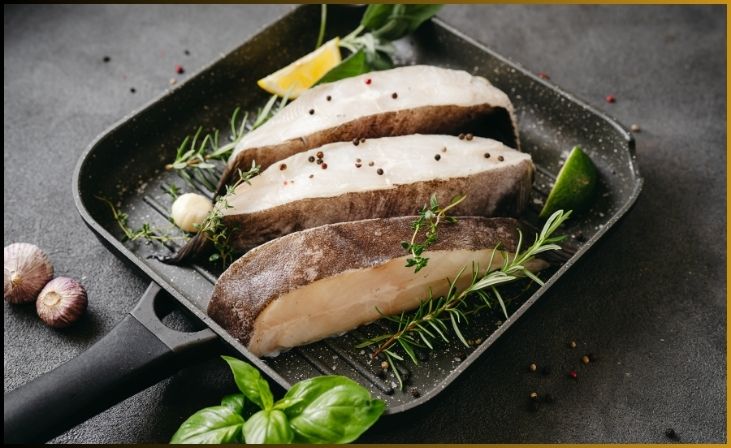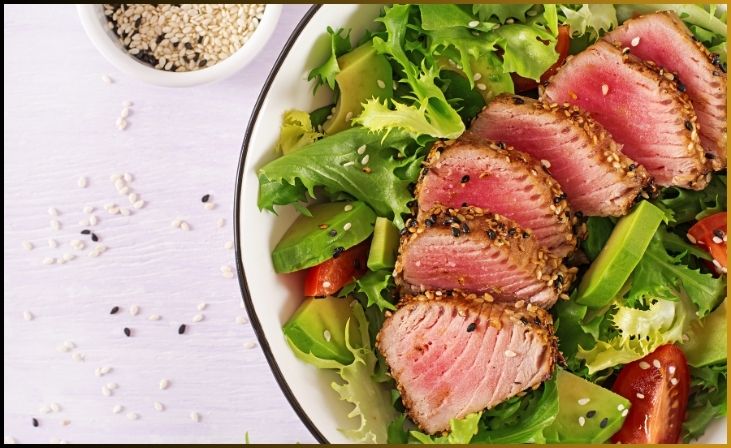Fresh halibut, with its tender, flaky flesh and mild, sweet flavor, is a prized catch for seafood enthusiasts. Whether you’ve reeled in a halibut from a fishing trip or found it at a local seafood market, knowing the best way to cook this delectable fish is essential to fully savor its taste and texture. In this guide, we’ll explore some expert tips and techniques to cook fresh halibut that’s mouthwateringly delicious.
From grilling to baking, there are various cooking methods to suit your preferences and culinary skills. We’ll dive into the nuances of each approach, helping you choose the best one for your needs. Plus, we’ll share some delectable recipes that showcase the versatility of halibut in different cuisines.
So, whether you’re a seasoned home chef or just starting your seafood culinary adventure, join us as we unravel the secrets to cooking fresh halibut to perfection.
Best Way to Cook Fresh Halibut
Cooking this prized fish to perfection requires attention to detail and a grasp of various techniques. Whether grilling, baking, pan-searing, or steaming, each method can highlight the fish’s natural taste. Let’s explore different cooking methods, along with tips to ensure your halibut dish is a delectable culinary masterpiece. From enhancing its flavor with simple seasoning to pairing it with complementary ingredients, there are numerous ways to create a memorable halibut dish that delights the taste buds.
Preparing the Halibut

Before embarking on your culinary journey with fresh halibut, the preparation process is key to achieving a delectable dish. Start by gently patting the halibut fillet dry with a paper towel. This step removes any excess moisture and ensures a more even cooking process.
Next, generously season both sides of the fillet with salt and pepper. This seasoning not only adds flavor but also enhances the natural taste of the fish. Allow the seasoned fillet to rest at room temperature for a few minutes. This brief period of rest is vital as it helps the seasonings to penetrate the fish, resulting in a more flavorful and well-balanced taste.
This simple yet crucial preparation step sets the stage for a successful halibut dish, ensuring that the flavors are harmoniously integrated into every bite. It’s a small investment of time that reaps great rewards in terms of taste and texture when cooking fresh halibut.
The Preheating Process
To attain that coveted sear on your halibut, the choice of a properly preheated skillet is absolutely essential. Opt for a skillet that’s specifically designed for high-heat cooking, such as cast iron, stainless steel, or a reliable non-stick skillet. These options are known for their excellent heat retention and even distribution, ensuring an ideal cooking surface.
Place your chosen skillet over medium-high heat, giving it time to gradually reach the desired temperature. Once it’s sufficiently heated, add a high-heat oil like olive oil or clarified butter. This step is crucial for achieving that perfect search. The oil should be just about to reach its smoking point, signified by a subtle wisp of smoke rising from the surface.
By using this technique, you create the ideal searing conditions for your halibut. The hot skillet and the sizzling oil will ensure that the fish forms a beautiful, golden-brown crust while locking in its natural flavors and moisture. It’s a vital step in the cooking process that contributes to the overall deliciousness of your halibut dish.
Quick Link: Excess Blueberries? 6 Creative Ways to Make the Most of Your Harvest
Searing Skin-Side Down

With your skillet properly preheated and the oil shimmering, it’s time to gently lay the halibut fillet into the skillet, positioning it skin-side down. This initial step serves a dual purpose in the cooking process. First, it allows the skin to crisp up, adding a delightful crunch to the dish. Second, it imparts a rich and savory flavor to the fish, enhancing its overall taste.
As the halibut fillet makes contact with the hot skillet, you’ll be greeted with a satisfying sizzle. This sound is a reassuring indication that you’re on the right track in achieving that sought-after sear. The sizzle not only signifies proper heat but also the beginning of the transformative process that will turn your halibut into a culinary masterpiece.
Taking care during this step ensures that the fillet cooks evenly and develops that desirable golden-brown crust. The skin-side-down approach not only enhances texture and flavor but also adds a visually appealing element to your halibut dish, making it a feast for the senses.
The Art of Not Moving
When you’ve gently placed the halibut fillet in the skillet, it’s crucial to resist the temptation to move or flip it immediately. Allowing the fillet to sit undisturbed is where the magic of searing occurs. During this crucial moment, the heat interacts with the fish, forming a beautifully golden and flavorful crust.
This crust serves as a barrier that locks in the moisture, preventing the fish from drying out during the cooking process. Moreover, it enhances the taste by creating a contrast between the crisp outer layer and the tender, flaky interior. The patience to let the searing process work its wonders is a hallmark of achieving that sought-after restaurant-quality sear.
So, as the halibut continues to sizzle in the skillet, trust the process and give it the time it needs to develop that perfect crust. This simple yet pivotal step ensures that every bite of your halibut is a harmonious balance of textures and flavors, making your culinary creation truly exceptional.
Cooking Time for Perfection
As you continue to cook the halibut, maintaining the skin-side-down position for about 3-4 minutes is key. This precise timing is instrumental in achieving the desired outcome. During this period, the skin undergoes a delightful transformation, becoming crispy and taking on a gorgeous golden hue.
The beauty of this cooking time is twofold. Firstly, it renders the skin, which means it becomes wonderfully crisp and adds a layer of enjoyable crunch to your dish. This textural contrast contributes to a more exciting eating experience. Secondly, this step plays a vital role in preserving the moisture within the fish, ensuring that the halibut remains tender and succulent.
The timing is a balance of texture and taste, where the exterior achieves perfection while the interior maintains its delicate and flaky nature. It’s in these 3-4 minutes that the true magic of searing happens, elevating your halibut from an ordinary meal to an exceptional culinary delight.
Flipping with Finesse
With your halibut fillet skin-side down, it’s time for a pivotal moment in the cooking process. Using a spatula, gently and carefully flip the fillet over to reveal the flesh side. This transition is crucial for achieving even cooking throughout the fish.
Now, the fillet’s flesh should be facing down in the skillet, and you’ll immediately notice a striking and delightful contrast. The seared skin, golden and crispy, stands in beautiful juxtaposition to the delicate and tender interior of the halibut. This visual and textural interplay is a testament to a perfectly executed sear.
The flip not only adds to the overall presentation but also ensures that the halibut’s flavor and texture are harmoniously balanced. It’s a culinary moment where aesthetics and taste come together, elevating your dish to a whole new level of enjoyment. Proceed with this transition with care, and you’ll be on the path to a masterful halibut creation.
Finishing Touches
As you continue cooking the halibut with the flesh side down, allow it to sizzle in the skillet for another 2-3 minutes. The objective here is to reach a state of opaqueness and flakiness that can be effortlessly achieved with a fork.
This brief additional cooking period is essential in ensuring that the fish is fully cooked throughout while retaining its natural moistness. It’s a delicate balance to maintain the perfect texture—tender and flaky, yet thoroughly cooked. The 2-3 minutes on the flesh side play a crucial role in achieving this culinary balance.
With the right timing and precision, you’ll unveil a halibut fillet that’s not only visually appealing with its golden crust but also a delight to the palate, thanks to its ideal texture and moisture content. This final step brings your halibut to its culinary peak, ready to be savored and enjoyed.
Also Read: A Nutritionist’s 10 Irresistible BBQ Menu Ideas
Resting for Excellence
As you’ve expertly cooked the halibut to perfection, the next critical step is to carefully remove it from the skillet. However, the culinary journey isn’t quite over yet. Before serving, it’s essential to let the halibut rest for about a minute.
This resting period is a crucial and often overlooked part of the cooking process. During this time, the juices within the fish redistribute, ensuring that each bite is succulent and brimming with flavor. It’s like giving the halibut a moment to settle and reach its peak of deliciousness.
The result is a fillet that’s not only visually stunning, with its golden sear and tender flesh, but also a delight to your taste buds. Every bite is a testament to your careful preparation and culinary expertise, offering a harmonious blend of textures and flavors. So, exercise a little patience and allow the halibut to rest—it’s the final touch that transforms your dish into a memorable dining experience.
Mastering the Art of Halibut Cooking
To master the art of cooking a perfect halibut fillet, follow these meticulous steps. Begin by preparing and seasoning the fillet, ensuring it’s ready to become a culinary masterpiece. Preheat a skillet over medium-high heat, choosing high-heat oil as the cooking medium.
With precision, place the halibut skin-side down to initiate the searing process. Allow it to sit undisturbed, fostering the development of a beautiful, flavorful crust. Cook for about 3-4 minutes on the skin side, watching as it turns a gorgeous golden hue.
Next, execute a gentle flip to reveal the flesh side and continue cooking for another 2-3 minutes. The goal here is to achieve an opaque and flaky texture, signifying the fish is perfectly cooked.
Once your halibut has reached its peak, carefully remove it from the skillet and allow it to rest for a minute. This critical step enables the juices to be redistributed, resulting in a succulent and flavorful bite.
Now, it’s time to serve and savor your culinary creation, knowing you’ve expertly cooked the halibut to perfection, ready to delight your taste buds.
Simple Steps, Spectacular Flavor
Cooking fresh halibut is a delightful culinary journey that need not be daunting. In fact, it can be a rather straightforward process. By adhering to these simple steps, you’ll unlock the secret to enjoying the delicate and exquisite flavors, as well as the tender, flaky texture that makes halibut a prized and sought-after seafood option.
These steps provide a structured and approachable method, ensuring that your halibut dish is a delicious success. The beauty of cooking halibut lies in its natural attributes and the simplicity of the process, allowing the fish to shine in all its glory.
With just a little patience and the right techniques, you’ll soon find that preparing fresh halibut is not only satisfying but also incredibly rewarding. Each bite of your perfectly cooked halibut will be a testament to your culinary expertise, showcasing the exceptional flavors and textures that this esteemed seafood has to offer.
Final Thoughts
Cooking fresh halibut offers a gateway to a delightful culinary experience. By understanding different cooking methods, proper seasoning, and suitable accompaniments, you can create a mouthwatering halibut dish that celebrates the natural flavors of this exquisite fish. Whether you choose grilling, baking, or any other method, the goal remains the same: to create a dish that tantalizes the taste buds and leaves a lasting impression.
FAQs
Halibut has a delicate flavor, so a light touch with seasoning is ideal. Herbs like dill, thyme, and parsley, along with a squeeze of lemon and a sprinkle of salt and pepper, complement its taste without overpowering it.
Properly cooked halibut will flake easily with a fork and will turn from translucent to opaque. Cooking time varies by method and thickness, but generally, it should reach an internal temperature of 145°F.
Grilling halibut works excellently. Ensure the grill is preheated and the fish is well-oiled to prevent sticking. Cook for about 4-6 minutes per side, depending on thickness.
Complement the mild taste of halibut with sides like roasted vegetables, a fresh salad, or quinoa. Light sauces like a lemon-butter drizzle or a simple herb vinaigrette can also elevate the dish.







